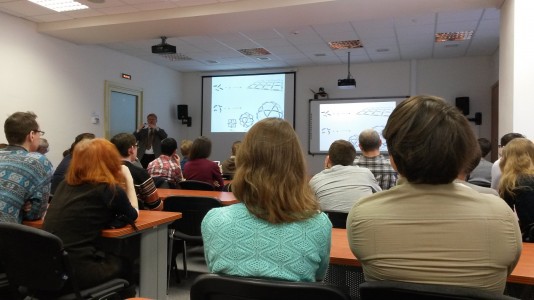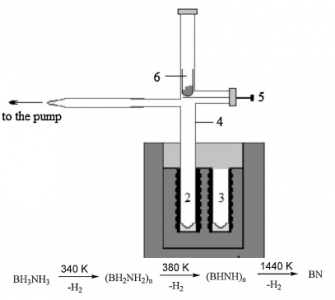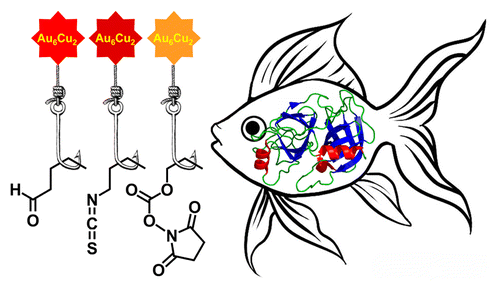
Благодарим участников пятого международного симпозиума по металлоорганической химии “STRONG LINKS VIA WEAK INTERACTIONS” за интересные доклады.
Archive for 26.01.2016
STRONG LINKS VIA WEAK INTERACTIONS
Thermochim. Acta 2015
Yu. Kondratev, A. Butlak, I. Kazakov, A. Timoshkin
“Sublimation and thermal decomposition of ammonia borane: Competitive processes controlled by pressure”
Thermochim. Acta, 2015, in press
DOI:10.1016/j.tca.2015.08.021

Thermal behavior of ammonia borane BH3NH3 (AB) has been studied by calorimetry, tensimetry and mass spectrometry methods. It is shown, that depending on vapor pressure in the system two competitive processes are taking place at 357 K. At atmospheric pressure thermal decomposition with hydrogen evolution is the dominant process: BH3NH3(s) = 1/n (BH2NH2)n(s) + H2(g) (1). At low pressures (circa 4 mTorr) the major process is endothermic sublimation of AB: BH3NH3(s) = BH3NH3(g) (2). At intermediate pressures both processes occur simultaneously. Enthalpies for the processes (1) and (2) have been determined by drop-calorimetry method: Δ(1)H357° = −24.8 ± 2.3 kJ mol−1 and ΔsubH357°(BH3NH3) = 76.3 ± 3.0 kJ mol−1. Solid products after sublimation and decomposition have been characterized by IR and NMR spectroscopy; gaseous forms were studied by mass spectrometry. Activation energy of 94 ± 11 kJ mol−1 for the process (1) in range 327–351 K was determined by static tensimetry method. Based on the analysis of available thermodynamic characteristics, new values for the standard formation enthalpy of solid AB −133.4 ± 5.2 kJ mol−1 and polyamidoborane −156.7 ± 5.8 kJ mol−1 are recommended.
Семинар 26.01.2016
Во вторник 26 января в 11-30 в аудитории 1093 (Конференц зал РЦ) состоится: Пятый международный симпозиум по металлоорганической химии “STRONG LINKS VIA WEAK INTERACTIONS”
 |
11:30—12:00 Kari Rissanen “Self-Assembly of Large Metallosupramolecular Complexes” (University of Jyväskylä, Finland) |
 |
12:00—12:20 Armando J. L. Pombeiro “Resonance-Assisted Hydrogen Bonding as a Synthetic Tool” (Instituto Superior Técnico, Lisbon, Portugal, and RSF International Laboratory on Organometallic Chemistry, Saint Petersburg State University) |
 |
12:40—13:10 Matti Haukka “Dihalogens as Halogen Bond Donors” (University of Jyväskylä, Finland) |
 |
13:10—13:30 M. Fatima Guedes da Silva “Hydrogen Bonding in Water Containing Metal Coordination Compounds” (Instituto Superior Técnico, Lisbon, Portugal, and RSF International Laboratory on Organometallic Chemistry, Saint Petersburg State University) |
Bioconjugate Chem., 2015
A.A. Beljaev, D.V. Krupenya, E.V. Grachova, V.V. Gurzhiy, A.S. Melnikov, P.Yu. Serdobintsev, E.S. Sinitsyna, E.G. Vlakh, T.B. Tennikova, S.P. Tunik
“Supramolecular AuI-CuI complexes as new luminescent labels for covalent bioconjugation”
Bioconjugate Chem., 2015
DOI:10.1021/acs.bioconjchem.5b00563

Two new supramolecular organometallic complexes, namely, [Au6Cu2(C2C6H4CHO)6(PPh2C6H4PPh2)3](PF6)2 and [Au6Cu2(C2C6H4NCS)6(PPh2C6H4PPh2)3](PF6)2, with highly reactive aldehyde and isothiocyanate groups have been synthesized and characterized using X-ray crystallography, ESI mass spectrometry, and NMR spectroscopy. The compounds obtained demonstrated bright emission in solution with the excited-state lifetime in microsecond domain both under single- and two-photon excitation. The luminescent complexes were found to be suitable for bioconjugation in aqueous media. In particular, they are able to form the covalent conjugates with proteins of different molecular size (soybean trypsin inhibitor, human serum albumin, rabbit anti-HSA antibodies). The conjugates demonstrated a high level of the phosphorescent emission from the covalently bound label, excellent solubility, and high stability in physiological media. The highest quantum yield, storage stability, and luminance were detected for bioconjugates formed by covalent attachment of the aldehyde-bearing supramolecular AuI–CuI complex. The measured biological activity of one of the labeled model proteins clearly showed that introduced label did not prevent the biorecognition and specific protein–protein complex formation that was extremely important for the application of the conjugates in biomolecular detection and imaging.
Декабрь
В декабре выполнено 1778 заявок на сервисные измерения.
Измерено:
- 1720 спектров 1H
- 285 спектров 13C
- 175 спектров DEPT
- 20 спектров COSY
- 19 спектров NOESY
- 75 спектров 31Р
- 67 спектров 19F
Выполнено 196 заявок на исследовательскую работу.